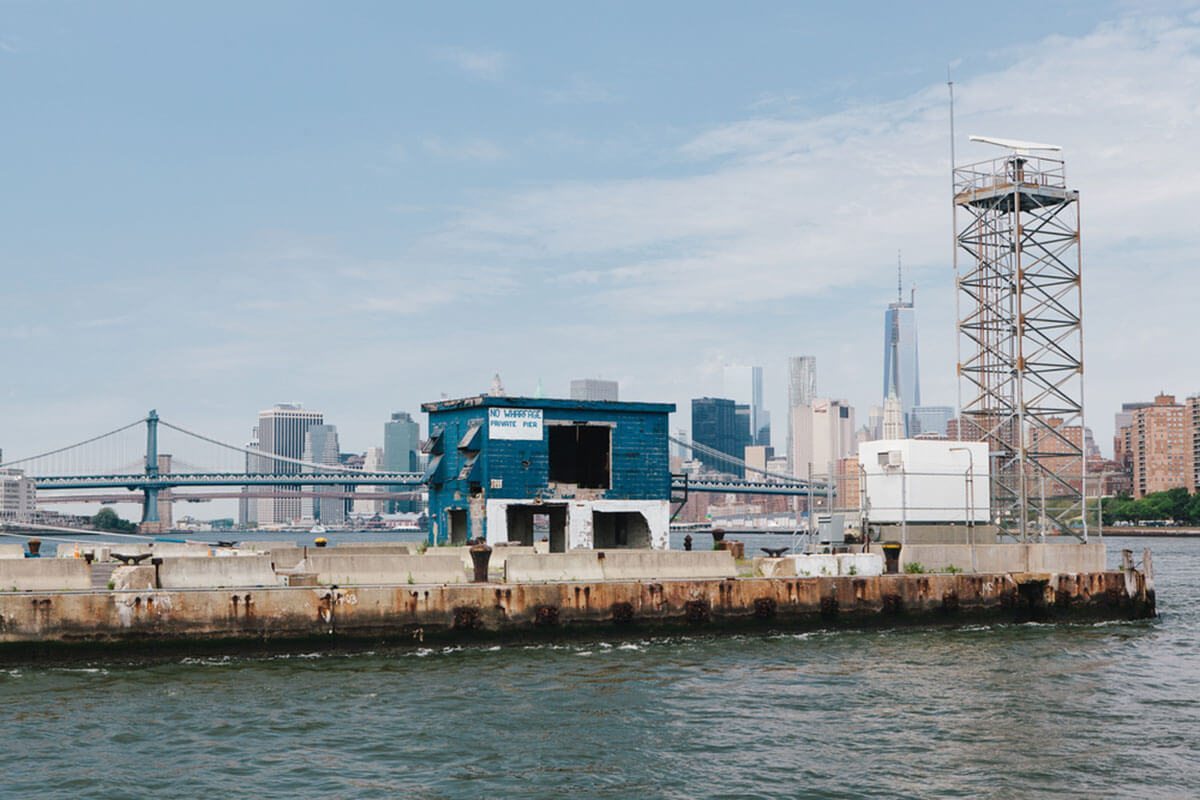Brooklyn Navy Shipyard

For over 150 year the Brooklyn Navy Yard produced some of the country’s most famous naval ships, including the USS Maine and USS Missouri. It played a pivotal role during World War II, becoming known as the “Can-Do Yard” thanks to the tireless efforts of more than 70,000 servicemen and women as well as civilian employees.
The Brooklyn Navy Yard built numerous aircraft carriers and battleships and also repaired more than 5,000 ships. Troops and supplies were sent around the world from the yard. The U.S. Navy decommissioned the Brooklyn Navy Yard in 1966 and the land was sold to the City of New York in 1968.
History
Even though the Brooklyn Navy Yard was not officially established until 1806, merchant vessels were being built on the site soon after the Revolutionary War. The architect of the first structure built there, the commandant’s house, was Charles Bulfinch—the architect of the United States Capitol Building in Washington, D.C. The Brooklyn Navy Yard was also the construction site of Robert Fulton’s steam frigate, the Fulton, which was launched in 1815. By the time of the Civil War, more than 6,000 men worked at the Brooklyn Navy Yard.
The yard made even more of an impact during the Second World War. By the time the U.S. became involved in the conflict, there were more than five miles of paved roads on the property, four dry docks, two steel shipways, and even a power plant, radio station and a railroad spur. The battleship North Carolina was built at the Brooklyn Navy Yard, as was the USS Missouri, which was the site of the official Japanese surrender on September 2, 1945.
Closure and Present-Day Use
Eventually there was less demand for naval ships, and the Brooklyn Navy Yard was closed.
The City of New York operated the yard after purchasing it from the U.S. Navy in 1968, and leased the facility to Seatrain Shipbuilding. Seatrain went on to build four crude carriers that were the largest ships ever built at the Brooklyn Navy Yard. The final ship built on the site was the crude carrier Bay Ridge. When Seatrain closed in 1979, the history of Brooklyn shipbuilding came to an end.
Today, the yard is a private manufacturing and commercial site that is home to more than 200 entrepreneurial businesses and 5,000 employees. It was listed on the National Register of Historic Places in 2014, and several buildings have been given landmark status.
Asbestos Use at the BNY
Although the Brooklyn Naval Yard has an incredibly proud and rich history, it was also a place where asbestos was used every day.
Asbestos was used throughout the ships built and repaired at the yard. When ships were being constructed and overhauled in Brooklyn, asbestos-containing equipment such as boilers, turbines, pumps and valves was installed and repaired. The yard also had numerous shops where asbestos-containing equipment was repaired. Thousands of civilian employees and Navy veterans were exposed to asbestos at the Brooklyn Navy Yard.
If you or a loved one worked or served at the Brooklyn Navy Yard and have been diagnosed with mesothelioma, contact Belluck & Fox, LLP, for a free case review.
Belluck & Fox, based in New York, has represented hundreds of veterans and yardbirds who were exposed to the asbestos at the Brooklyn Navy Yard and diagnosed with mesothelioma or lung cancer. Let us help you protect you and your family.
The following is a list of ships constructed or repaired at the Brooklyn Navy Ship Yard. This list includes Destroyers, Cutters, Cruisers, Battleships, Frigates, Gunboats, Torpedo Boats and Carriers.
A
USS Adirondack (AGC15)
USS Alarm
USS Albany
USS Alexander Hamilton
USS Algonquin
USS Antietam (CV36)
USS Arizona (BB39)
USS Austin (LPD4)
B
USS Bennington (CV20)
USS Bon Homme Richard (CV31)
USS Brooklyn (CL40)
C
USS Cincinnati
USS Connecticut (BB18)
USS Constellation (CVA64)
D
USS Dale (DD353)
USS Decatur
USS Dolphin (SS169)
USS Duluth (LPD6)
E
USS Enterprise (CVN65)
USS Erie (PG50)
F
USS Fairfield
USS Florida (BB30)
USS Franklin (CV13)
USS Franklin D. Roosevelt (CV31)
USS Fulton
H
USS Helena (CL50)
USS Holder
USS Honolulu (CL48)
USS Hornet (CV12)
USS Hull (DD350)
I
USS Independence (CVA62)
USS Indiana (BB58)
USS Iowa (BB61)
USS Iroquois
J
USS Java
USS John C. Spencer
K
USS Kalamazoo
USS Kearsarge (CV33)
USS Kenosha
L
LST 311-318
USS Lackawanna
USS La Salle (LPD3)
USS Levant
USS Lexington (CV16)
M
USS Mackinaw
USS Madawaska
USS Maine (BB69)
USS Maumee
USS Menges
USS Miantonomah
USS Missouri (BB63)
USS Morris
USS Mosholu
N
USS New Hampshire (BB70)
USS New Mexico (BB40)
USS New Orleans (CA32)
USS New York (BB34)
USS Niagara (PG52)
USS North Carolina (BB55)
USS Nyack
O
USS Octorora
USS Ogden (LPD5)
USS Ohio (BB68)
USS Oneida
USS Ontario
USS Oriskany (CV34)
P
USS Peacock
USS Pensacola (CL24)
USS Peoria
USS Pilot
USS Puritan
Q
USS Quinnebaug
R
USS Raleigh (LPD1)
USS Reprisal (CV35)
S
USS Sabine
USS San Jacinto
USS Saratoga (CVA60)
USS Savannah
USS Shamrock
USS Somers
USS South Dakota
USS Subchasers (SC5-SC64)
USS Swatara
T
USS Tennessee (BB43)
USS Terror (BM4)
USS Ticonderoga (CV14)
USS Trenton
USS Tullahoma
V
VF 221
USS Vancouver (LPD2)
USS Vestal
USS Vincennes
W
USS Wampanoag
USS Wasp (CV18)
Y
YR34-35
YSD-7
